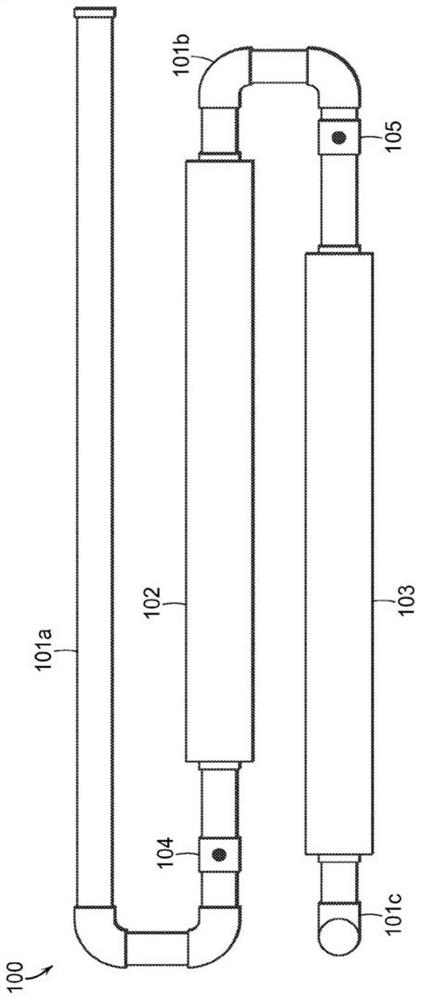Compositions for treating biofilms without inducing antimicrobial resistance
An anti-microbial and composition technology, applied in the fields of botanical equipment and methods, drug combinations, applications, etc., can solve the problems of prolonged exposure, difficulty in handling biofilms, inability to handle biofilms, etc., to maintain wound hydration and long-term contact. time, the effect of promoting healing
- Summary
- Abstract
- Description
- Claims
- Application Information
AI Technical Summary
Problems solved by technology
Method used
Image
Examples
Embodiment 1
[0177] Embodiment 1: product analysis
[0178] When spectrophotometry is extended to also cover the visible range, color can be detected. The gas usually produced during HOCl production is ClO 2 , Cl 2 O and Cl 2 , all of these gases are detectable as yellow or yellow-red in the visible range. Tzanavaras et al. (Central European J. of Chemistry, 2007, 5(1) 1-12). Figure 9 The data in illustrate that HOCl produced by the method of the present invention shows no absorption from colored gases, as indicated by the absence of colored species. HOCl is known to generate a peak at 292 nm (Feng et al., 2007, J. Environ. Eng. Sci. 6, 277-284).
Embodiment 2
[0180] HOCl produced by the above process was stored under thermal stress at 40 °C to accelerate degradation using four different types of aqueous solutions: (1) reagent grade water (deionized water); (2) tap water; (3) with phosphoric acid Reagent grade water with saline buffer; and (4) tap water with phosphate buffer. The profile of the HOCl product was monitored after initial reaction (T=0); 4 weeks (T=4); 8 weeks (T=8); and 12 weeks (T=12).
[0181] Figure 10 is a graph showing the amount (parts per million (ppm)) of HOCl initially produced (T=0) and its stability over time. The data showed that reagent grade water (deionized water) without phosphate buffer was most stable over 12 weeks, showing minimal product degradation from initial production. Deionized water produced a much more stable product than that produced using tap water. Additionally, and surprisingly, the data show that phosphate buffer may have a negative impact on the amount of HOCl product produced.
...
Embodiment 3
[0184] Example 3: Acetic Acid Compared to Hydrochloric Acid
[0185] Using the process described above, hydrochloric acid (HCl) and acetic acid were used to produce HOCl, which was then stored under thermal stress at 40 °C. The amount of HOCl produced initially (T=0) was recorded, followed by the amount of HOCl product remaining after 12 days. Each produces three batches. The data for HCl to HOCl are shown in Table 1. The data for HOCl produced from acetic acid are shown in Table 2.
[0186] Table 1: HOCl produced from HCl
[0187]
[0188] Table 2: HOCl Production from Acetic Acid
[0189]
[0190] The data showed that use of acetic acid provided greater product stability, most likely due to greater pH stability. Without being bound by any particular theory or mechanism of action, it is believed that the different protonation ability of acetic acid (ie, acetic acid donates fewer protons to the liquid than hydrochloric acid) results in a higher stability of HO...
PUM
| Property | Measurement | Unit |
|---|---|---|
| length | aaaaa | aaaaa |
| diameter | aaaaa | aaaaa |
| diameter | aaaaa | aaaaa |
Abstract
Description
Claims
Application Information
 Login to View More
Login to View More - R&D
- Intellectual Property
- Life Sciences
- Materials
- Tech Scout
- Unparalleled Data Quality
- Higher Quality Content
- 60% Fewer Hallucinations
Browse by: Latest US Patents, China's latest patents, Technical Efficacy Thesaurus, Application Domain, Technology Topic, Popular Technical Reports.
© 2025 PatSnap. All rights reserved.Legal|Privacy policy|Modern Slavery Act Transparency Statement|Sitemap|About US| Contact US: help@patsnap.com



